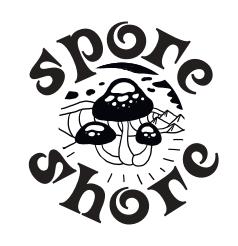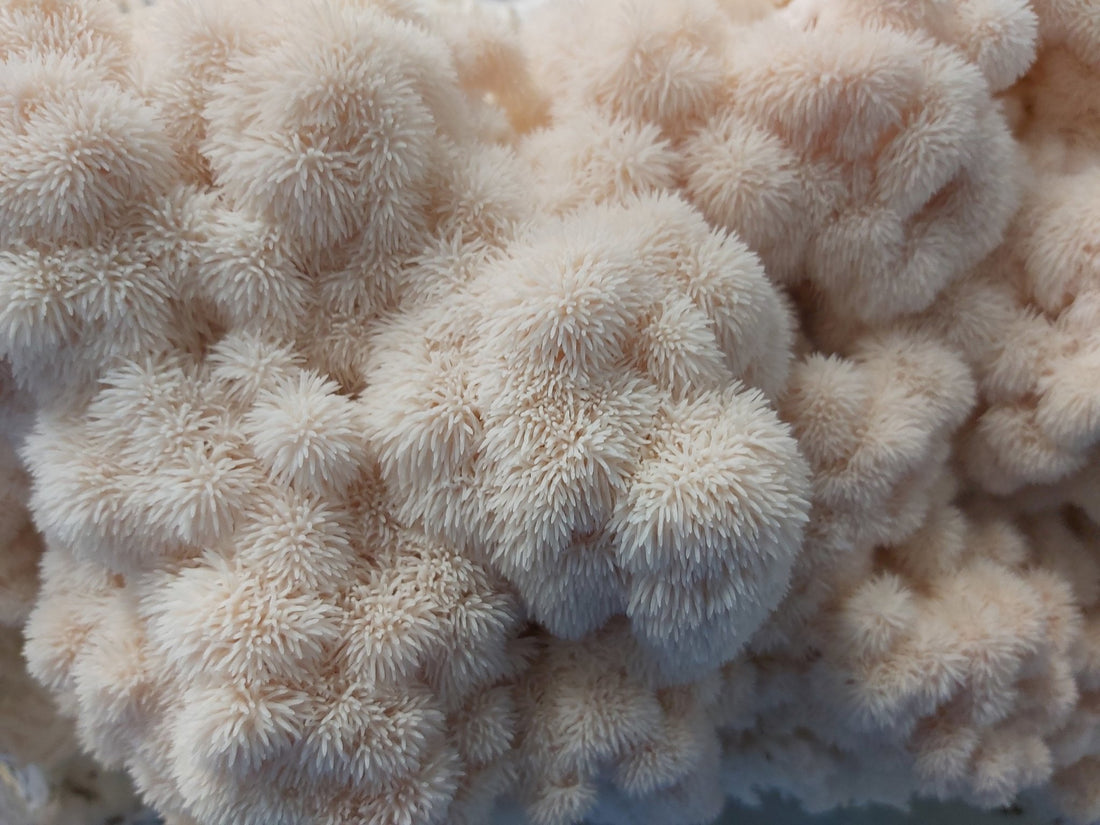Lions’ mane mushroom is both a culinary and medicinal mushroom. This striking mushroom is often found across the world on hardwood tree trunks such as oak. It has a long history of usage and in modern times research has shown many promising benefits through supplementation of Lions mane mushroom extracts. Research on this fascinating mushroom shows great potential in health benefits such as nerve support, protection against dementia and help with anxiety and depression.

Through a naturally occurring peptide known as NGF (Nerve Growth Factor) found within Lions Mane mushroom. NGF has the capability to improve brain function and the nervous system. NGF can prevent or reduce degeneration of neurons, inflammation and can contribute to nerve repair and increased mental capacity. Within Lions’ mane mushroom (fruiting body) has two main families of compounds these are Hericenones and erinacines.
The main bioactive substances within Lions Mane Mushroom are Hericenones and Erinacines. The Hericenones in Lions Mane mushroom was shown to improve the myelination process in myelinating fibers, this could have potential benefits for MS patients.[1] In addition compounds Hericenones C, D, E, and F found in Lions Mane Mushroom were shown to have the ability to stimulate NGF in a controlled study.[2] In another study six out of seven patients noticed improvement in their memory and communication. While all seven also noticed improvements in functional independence scores after taking Lions Mane 5g daily for 6 months.[3] Furthermore, thirty patients between the ages of fifty to eighty and who had mild symptoms of dementia were given Lions Mane Mushroom. Significant increases in cognitive ability were found in the treatment group. However, four weeks after the conclusion of the trial, cognitive ability dropped showing a need for continued supplementation.[4]

Now on to the other main compound of interest within Lions Mane. The Erinacines are terpenoids found in Lions Mane mycelium. [5] Recent studies have suggested that lion’s mane mycelium contains increased amounts of erinacines within the mycelium compared with just the mushroom itself. Both Lions Mane Mycelium and fruiting body contain a wide range of bio active compounds that show anti-inflammatory activity and promote nerve growth factor. However, it is the mycelium which shows great promise for the treatment of cognitive conditions, including Alzheimer’s and Parkinson’s disease. A research model into Parkinson’s disease which tested mycelium ethanol extracts, showed promising post treatment neurotrophic and neuroprotective benefit.
Furthermore, In a study by Chen, Erinacines were found to repair damage from neuromuscular or nerve injury and aid in the growth of new neurites.[6] In a clinical trial in Japan extracts of Lions Mane Mushroom and mycelium showed anti-MRSA activity with erinacines being identified as the main active compound. [7] Lions’ mane mycelium extract was used in a two-week study to treat chronic repeated stress in mice reversing their symptoms. This showed that Lions mane mycelium extract could have the potential in helping regulate dopamine, serotonin, and epinephrine levels. [8] In a clinical trial lasting four weeks women experiencing menopausal symptoms were given mycelium extracts, everyone reported improved concentration, anxiety, and depression.[9] If you are interested in Lions Mane Mycelium extracts. You can find our very own locally grown and produced high strength mycelium ethanol extract here.
In sum this alluring mushroom shows great potential in health benefits such as nerve support, protection against dementia, help with anxiety and depression, hormone health and improvement in cognitive abilities. There are benefits not just in the Lions Mane Mushroom but also in Lions Mane’s Mycelium. Including the mycelium within extracts should greatly enhance the erinacine content and help increase the overall efficacy of the extract to better utilise the many benefits of the erinacines and their potent effects. Lions’ mane mushroom and its mycelium’s effects are exciting for future study.

[2] The Miracle Mushroom Hericium erinaceus and its Relation to NGF, Luke Neal
[3] Pp3522Medicinal Mushrooms: a clinical guide Martin Powell
[4] Pp3522 Medicinal Mushrooms: a clinical guide Martin Powell
[5] Pp53, Medicinal Mushrooms: the human clinical trials Robert Dale Rogers
[6] Pp53, Medicinal Mushrooms: the human clinical trials Robert Dale Rogers
[7] Pp3522 Medicinal Mushrooms: a clinical guide Martin Powell
[8] See pp130 Richard Bray Healing Mushrooms – a practical guide to medicinal mushrooms
[9] See pp130 Richard Bray Healing Mushrooms – a practical guide to medicinal mushrooms

